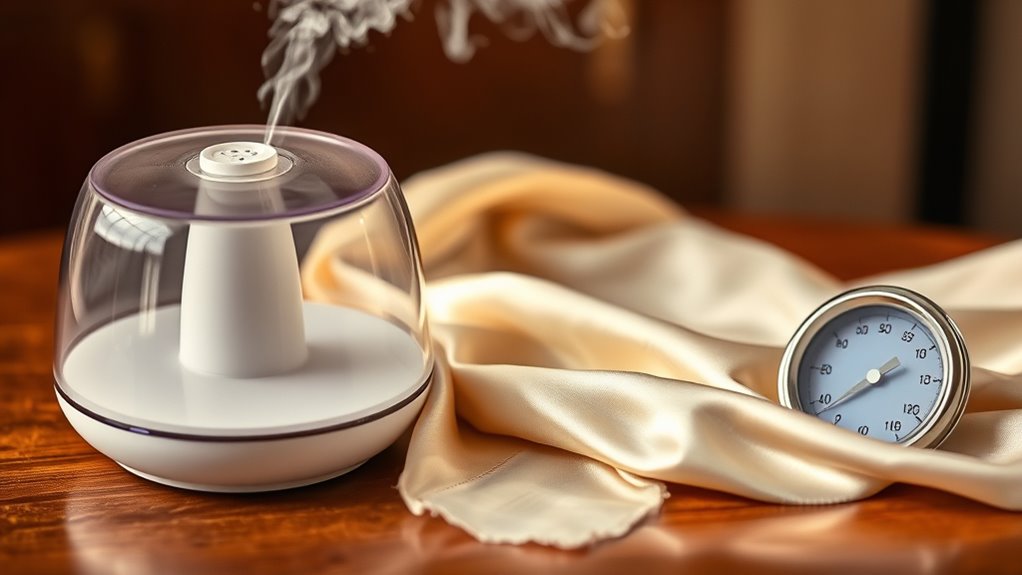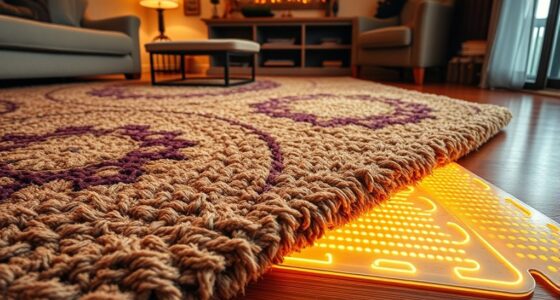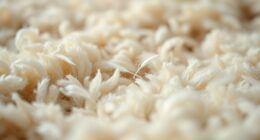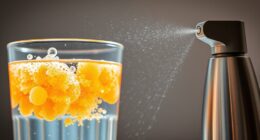To protect silk in dry climates, you need a reliable humidifier and hygrometer to maintain stable humidity levels around 50-55%. Choose ultrasonic or evaporative models for consistent moisture and easy calibration. Place the equipment properly away from direct sunlight and check humidity regularly. Keep devices clean and monitor to prevent over- or under-humidification, which can damage your silk. Follow these tips, and you’ll discover more ways to preserve your textiles effectively.
Key Takeaways
- Maintain humidity levels around 50-55% using calibrated humidifiers to prevent silk brittleness and fiber damage.
- Regularly calibrate hygrometers for accurate moisture readings and adjust humidifiers accordingly.
- Position humidifiers away from silk artifacts, on flat surfaces, and away from direct sunlight to prevent damage.
- Clean and maintain humidifiers and filters regularly to prevent mold, bacteria, and mineral buildup.
- Use environmental controls like UV covers and acid-free storage to complement humidity regulation and preserve silk quality.
Understanding the Impact of Low Humidity on Silk
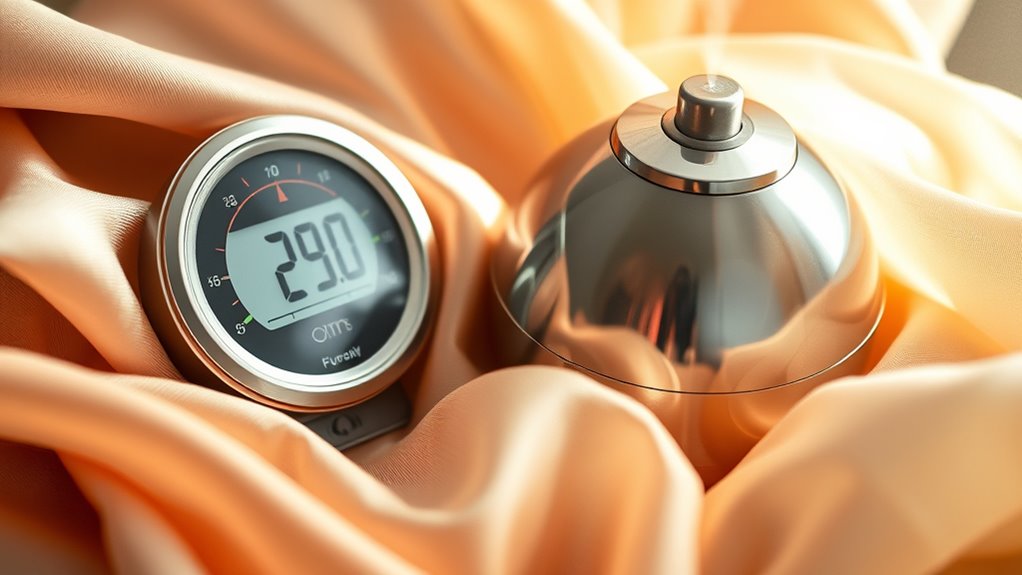
Low humidity can substantially damage silk, causing it to become brittle, dry, and prone to cracking. When the air lacks moisture, the silk fiber loses its natural elasticity, making it fragile and more susceptible to tears. Without proper preservation techniques, exposure to dry conditions accelerates deterioration, compromising the fabric’s strength and appearance. Silk’s delicate structure relies on a balanced environment to maintain its luster and flexibility. In low humidity settings, the fibers shrink and weaken, leading to permanent damage if left unprotected. To safeguard your silk items, understanding how low moisture levels affect the fiber is essential. Recognizing the importance of environmental control helps in implementing effective preservation techniques that maintain the silk’s integrity, preventing irreversible damage caused by dryness and environmental stress. Additionally, maintaining appropriate humidity levels can significantly extend the lifespan of delicate fabrics like silk, as environmental stress can further accelerate deterioration and compromise quality. Proper humidity management is crucial for ensuring the longevity of silk and other sensitive textiles, especially in dry climates. Furthermore, using devices like humidifiers and hygrometers can help maintain optimal conditions and protect your valuable silk collection.
Choosing the Right Humidifier for Silk Preservation
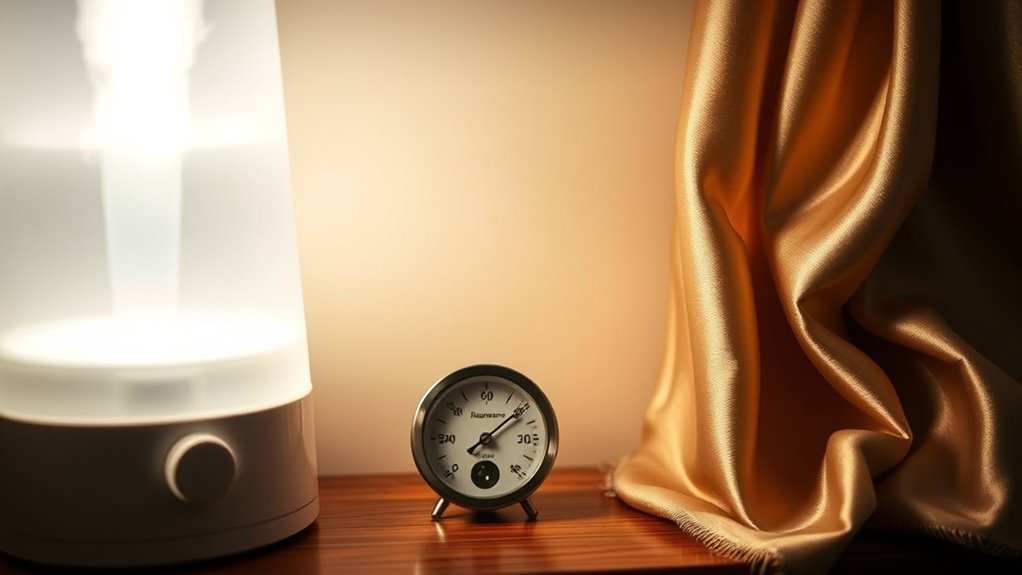
Selecting the right humidifier is essential for maintaining ideal conditions that protect silk from damage. A well-chosen device helps stabilize humidity levels, preserving silk fiber integrity and preventing the adverse effects of humidity fluctuation. Ultrasonic humidifiers provide consistent moisture output with minimal noise, making them suitable for delicate environments. Evaporative models use natural evaporation, reducing the risk of over-humidification. Avoid devices that produce large fluctuations or dry out quickly, as rapid changes can weaken silk fibers. Consider room size, ease of maintenance, and the ability to regulate humidity precisely. Proper selection ensures a stable environment, minimizes humidity fluctuation effects, and keeps your silk artifacts or garments in excellent condition. Additionally, selecting a humidifier with automatic humidity control can help maintain consistent levels without manual adjustments, further protecting delicate fabrics. Incorporating soundscapes and auditory elements can also enhance the environment, similar to the immersive storytelling used in engaging voiceover ads. Moreover, understanding the impact of angel number soulmate symbols can help in creating a harmonious atmosphere conducive to peace and preservation.
Monitoring Environment Conditions With Hygrometers

To effectively protect your silk artifacts, you need to keep a close eye on environmental conditions, and hygrometers are essential tools for this purpose. A hygrometer helps you monitor humidity levels, which directly affect the silk fiber’s integrity. By tracking humidity control, you can prevent the silk from becoming too dry or too moist, both of which cause damage over time. Regularly checking your hygrometer ensures you maintain an ideal environment, typically around 50-55% humidity. Keep in mind that fluctuations can accelerate deterioration, so consistent monitoring is key. Accurate readings allow you to take immediate action if conditions drift outside appropriate ranges, safeguarding your silk artifacts and preserving their beauty for years to come. Understanding time zone differences can also be useful if you are coordinating preservation efforts across different locations. Additionally, research shows that home security systems can help protect valuable collections by deterring theft or vandalism, ensuring your artifacts remain safe. Maintaining proper environmental conditions plays a critical role in artifact preservation, especially in dry climates where humidity levels can vary significantly.
Best Practices for Using Humidifiers and Hygrometers Together

To get the most out of your humidifier and hygrometer, you need to calibrate your devices regularly for accuracy. Keep an eye on humidity levels and maintain them within the recommended range, adjusting your settings as needed. Don’t forget to perform routine equipment checks to guarantee everything stays in good working order. Incorporating automation’s role in business intelligence can help monitor and analyze environmental data more efficiently. Regular calibration helps ensure your devices provide precise readings, which is especially important when caring for delicate items like silk in dry climates. Additionally, selecting a device with filter replacement indicators can help you stay on top of maintenance and ensure consistent performance. Proper maintenance and device longevity are crucial for optimal protection of sensitive materials like silk fibers in dry environments.
Calibrate for Accuracy
Ensuring your humidifier and hygrometer work together accurately is essential for maintaining ideal indoor humidity levels. To achieve this, regularly check and perform sensor calibration on your hygrometer. Proper calibration guarantees humidity accuracy, so you can trust the readings and make informed adjustments. Start by comparing your hygrometer’s reading with a reliable reference device or a salt test. If the readings are off, follow the manufacturer’s instructions to calibrate the sensor, which may involve adjusting a screw or resetting the device. Consistent calibration prevents false readings that could lead to over- or under-humidifying your space. Additionally, awareness of local divorce statistics can inform you about regional legal resources that may be helpful if you encounter legal issues related to property or other disputes. By maintaining sensor accuracy, you’ll keep your silk and other delicate items protected in dry climates, ensuring your environment stays at optimal humidity levels.
Maintain Optimal Levels
Regularly verifying your hygrometer’s accuracy lays a solid foundation for maintaining proper humidity levels, but it’s equally important to focus on how you use your humidifier and hygrometer together. To preserve antiques and textiles, aim for a consistent humidity range of 50-55%. Avoid fluctuations that can cause cracking or warping. Use your hygrometer to monitor levels closely and adjust your humidifier accordingly. During textile cleaning or antique preservation, maintaining stable humidity prevents damage caused by dryness or excess moisture. Keep the humidifier clean and free of mold to prevent contaminating delicate fabrics or antiques. Consistent monitoring and controlled humidity ensure your valuables stay in prime condition, protecting their integrity and extending their lifespan in dry climates. Additionally, staying aware of retail hours can help you access supplies or professional services when needed.
Regular Equipment Checks
Since your humidifier and hygrometer work together to control indoor humidity, performing regular equipment checks is essential for reliable performance. Regularly inspect your humidifier for signs of mineral buildup or mold, ensuring proper humidifier maintenance. Calibrate your hygrometer periodically to maintain accurate humidity readings, especially if the device is old or exposed to temperature changes. Verify that the humidifier’s water level sensor functions correctly and that the output remains consistent. Clean and replace filters as needed to prevent bacteria growth. Keep an eye on the hygrometer’s calibration using a simple salt test or calibration kit. Here are key checks to include:
- Inspect humidifier for buildup or mold
- Calibrate hygrometer regularly
- Verify water level sensors
- Clean filters and reservoirs
- Confirm consistent humidity readings
Tips for Maintaining Optimal Moisture Levels in Dry Climates

To keep your indoor air comfortable in dry climates, pay attention to where you place your humidifier—avoid corners or near vents. Regularly check your hygrometer to guarantee moisture levels stay within the ideal range. These simple steps help you maintain consistent, healthy humidity all year round.
Proper Humidifier Placement
Proper placement of your humidifier is crucial for maintaining ideal moisture levels, especially in dry climates. Position it in a central location, away from walls and furniture, to guarantee even distribution. Keep it on a flat, elevated surface to prevent spills and damage. Avoid placing it near sources of artificial fragrances, which can interfere with humidity and air quality. If your humidifier has electronic controls, ensure they’re easily accessible for adjustments. Be mindful to prevent direct airflow onto silk or delicate fabrics, which can cause damage. For excellent results, consider these tips:
- Place away from windows and vents
- Keep at least a few feet from silk artifacts
- Avoid direct sunlight exposure
- Use a humidifier with adjustable settings
- Regularly check for proper operation and cleanliness
Regular Moisture Monitoring
Are you regularly verifying your home’s humidity levels to make certain they stay within the ideal range? Monitoring moisture helps protect silk fiber properties from damage caused by dry air. Use a reliable hygrometer to track humidity daily, adjusting your humidifier as needed. Consistent checks prevent excessive dryness that could cause silk fibers to become brittle or crack. Remember, proper humidifier maintenance ensures accurate readings and peak performance. Keep your device clean and calibrated to avoid false measurements. Here’s why regular monitoring matters:
| Humidity Level | Effect on Silk Fiber Properties |
|---|---|
| 40-50% | Maintains silk’s flexibility |
| Below 40% | Puts silk at risk of brittleness |
| Above 50% | Promotes mold and damage |
| Optimal range | Protects silk from deterioration |
Additional Measures to Protect Silk Textiles in Challenging Environments
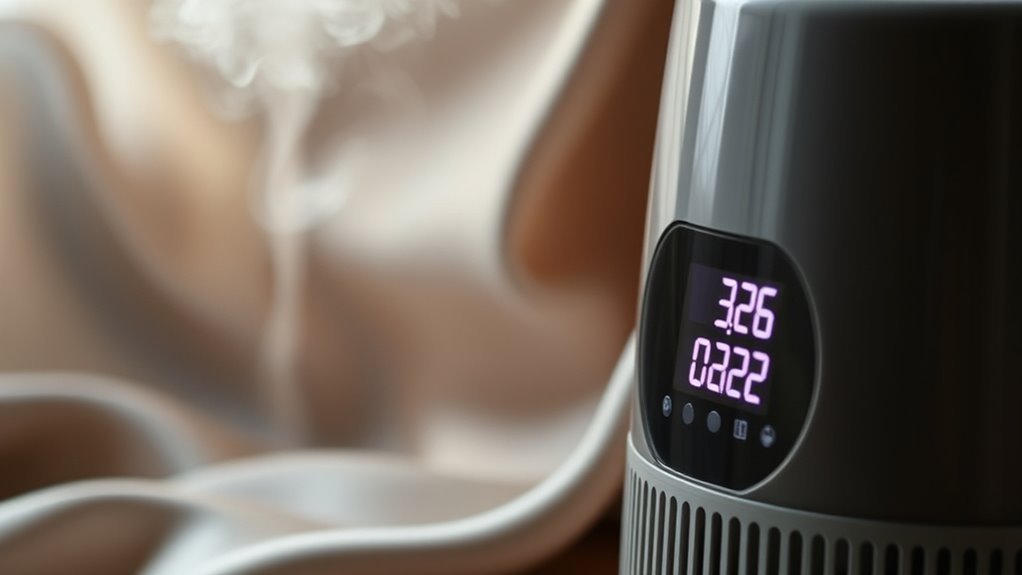
When silk textiles face challenging environments, taking extra protective measures becomes essential. You can enhance silk fiber flexibility and dye stability by implementing additional safeguards. Consider storing silk in acid-free containers to prevent chemical degradation. Using UV-filtering covers shields against sunlight damage. Maintaining stable temperature and humidity levels reduces stress on fibers. Employing barrier fabrics, like silk-lined covers, minimizes abrasion and dust exposure. Regularly inspecting textiles for signs of deterioration helps catch issues early. These steps help preserve the silk’s natural qualities, ensuring longevity in harsh conditions. By combining environmental controls with physical protections, you support the fabric’s integrity and appearance over time. These measures are crucial for safeguarding delicate silk textiles, especially in environments prone to fluctuations or pollutants.
Frequently Asked Questions
How Often Should I Calibrate My Hygrometer for Accuracy?
You should calibrate your hygrometer at least once a year to guarantee measurement accuracy. If you notice discrepancies or your environment changes markedly, consider calibrating more frequently. Regular hygrometer calibration helps you maintain precise humidity levels, which is essential for protecting delicate items like silk. Use a salt test or other calibration methods to verify its readings, and adjust accordingly to keep your measurements reliable and consistent.
Can Humidifiers Cause Mold or Damage to Silk?
Humidifiers can cause mold growth if you don’t regulate humidity levels, leading to potential silk deterioration. Excess moisture promotes mold, which damages delicate silk fabrics and causes staining or weakening. To prevent this, maintain proper humidity and make certain your humidifier isn’t overused. Regularly check for mold and clean your device. Proper humidity levels protect silk, avoiding mold growth and preserving its quality over time.
Are There Specific Humidifier Models Best Suited for Delicate Textiles?
When choosing a humidifier for delicate textiles, you should look for models with precise humidity controls. Proper humidifier maintenance is essential to prevent mold and ensure textile preservation. Ultrasonic or vaporizer humidifiers often work well because they offer consistent moisture without over-humidifying. Regularly cleaning your humidifier and monitoring humidity levels helps safeguard your silk and other delicate fabrics from damage in dry climates.
What Are Signs of Over-Humidification Damaging Silk Items?
Imagine your silk item as a delicate dance partner; excess moisture can trip it up. When over-humidified, you’ll notice mildew spots forming like tiny dark clouds, and the fabric stiffening, losing its supple grace. These signs tell you your environment has become too damp. Keep an eye on humidity levels, and your silk will continue to glide smoothly rather than suffer from the damaging effects of over-humidification.
How Do Seasonal Changes Affect Humidity Control Strategies?
You need to account for seasonal fluctuations because they directly impact humidity levels. As seasons change, you should adapt your humidity control strategies to maintain ideal conditions for silk. In winter, you might increase humidity to prevent drying, while in summer, you may need to reduce it to avoid excess moisture. Regularly monitor with hygrometers and adjust your humidifiers accordingly to guarantee consistent protection for your silk items year-round.
Conclusion
Just as a gentle hand preserves a delicate bloom, balancing humidity with your humidifier and hygrometer safeguards your silk. Keep moisture steady, like a steady heartbeat, to prevent damage in dry climates. With mindful care, you’ll ensure your silk remains as vibrant and resilient as a timeless masterpiece. Remember, in the dance of preservation, harmony between tools and environment is your guiding rhythm—keeping your treasured textiles forever graceful.
